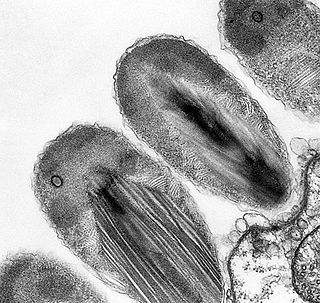
Acipenseriformes is an order of basal ray-finned fishes that includes living and fossil sturgeons and paddlefishes (Acipenseroidei), as well as the extinct families Chondrosteidae and Peipiaosteidae. They are the second earliest diverging group of living ray-finned fish after the bichirs. Despite being early diverging, they are highly derived, having only weakly ossified skeletons that are mostly made of cartilage, and in modern representatives highly modified skulls.

Goniurosaurus is a genus of geckos in the family Eublepharidae. The genus contains 27 species. Members species are known by various common names including cave geckos, ground geckos, leopard geckos, and tiger geckos. Members of this genus are found in China, Japan, and Vietnam. For this reason they are also known commonly as Asian geckos.

Hemiphyllodactylus is a genus of geckos ranging from India and China southward to Southeast Asia and Oceania. Species of Hemiphyllodactylus are commonly known as half leaf-fingered geckos. Many species are known as dwarf geckos or slender geckos.

Verrucomicrobiota is a phylum of Gram-negative bacteria that contains only a few described species. The species identified have been isolated from fresh water, marine and soil environments and human faeces. A number of as-yet uncultivated species have been identified in association with eukaryotic hosts including extrusive explosive ectosymbionts of protists and endosymbionts of nematodes from genus Xiphinema, residing in their gametes. The verrucomicrobial bacterium Akkermansia muciniphila is a human intestinal symbiotic bacterium that is considered as a promising probiotic.

Leptobrachella is a genus of frogs in the family Megophryidae. Members of Leptobrachella are found throughout Asia including on Borneo and the Natuna Islands. They are sometimes referred to as Borneo frogs, slender-armed frogs, or dwarf litter frogs. The genus contains over 82 species with 25 found in China alone.

Amolops is a genus of true frogs native mainly to eastern and south-eastern Asia. These frogs are closely related to such genera as Huia, Meristogenys, Odorrana, Pelophylax and Rana, but still form a distinct lineage among the core radiation of true frogs. They are commonly known as "torrent frogs" after their favorite habitat - small rapid-flowing mountain and hill streams - but this name is used for many similar-looking frogs regardless of whether they are loosely related.

Omeisaurus is a genus of sauropod dinosaur from the Middle Jurassic Period of what is now China. Its name comes from Mount Emei, where it was discovered in the lower Shaximiao Formation of Sichuan Province.

Szechuanosaurus is an extinct genus of carnivorous theropod dinosaur from the Late Jurassic. Fossils referred to the genus have been found in China, Asia in the Oxfordian-?Tithonian. Its type species is based on several undiagnostic teeth from the Kuangyuan Series. Additional possible specimens of Szechuanosaurus were also reported from the Kalaza Formation, also located in China.

Chienkosaurus is a dubious genus of carnivorous theropod dinosaur from the Late Jurassic Kuangyuan Series of China. It was probably related to Szechuanosaurus.

Meta is a genus of long-jawed orb-weavers that was first described by Ludwig Carl Christian Koch in 1835. They are often associated with caves, caverns, and recesses, earning some of them the name "cave orbweavers"
Sinocyclocheilus is a genus of freshwater fish in the family Cyprinidae that is endemic to Guangxi, Guizhou and Yunnan in China. Almost all of its species live in or around caves and most of these have adaptions typical of cavefish such as a lack of scales, lack of pigmentation and reduced eyes. Several species have an unusual hunchbacked appearance and some of the cave-dwellers have a "horn" on the back, the function of which is unclear. In contrast, the Sinocyclocheilus species that live aboveground, as well as a few found underground, show no clear cavefish adaptions. They are relatively small fish reaching up to 23 cm (9.1 in) in length. The individual species have small ranges and populations, leading to the status of most of the evaluated species as threatened. Many species populations in the genus have yet to be evaluated by the IUCN.

Triplophysa is a genus of fish in the family Nemacheilidae found mainly in and around the Qinghai-Tibet Plateau in China, as well as inland waters of the larger part of central Asia. They can be distinguished from other genera of Nemacheilidae by marked sexual dimorphism, including the development of nuptial tubercles on breeding males. Currently, the genus is a mixed assemblage of species. Some lineages have been identified and treated as subgenera, but as Wikipedia follows Fishbase for fish species all but Hedinichthys have been treated as subgenera in Wikipedia, although Kottelat in his revision of the loaches did recognise them as valid. FishBase, however, includes these in Triplophysa without specifying subgenera and treats the names given by Kottelat as synonyms.

Pelodiscus is a genus of turtles in the family Trionychidae, the softshells. Based on genetic and morphological analysis there are seven valid species. They are native to Eastern Asia, ranging from the Amur region, south through China and Korea, as far south as Vietnam. Populations in Japan are thought to likely originate from historic human introductions.

The Yixian Formation is a geological formation in Jinzhou, Liaoning, People's Republic of China, that spans about 1.6 million years during the early Cretaceous period. It is known for its fossils, listed below.

Pagetia is a genus of small trilobite, assigned to the Eodiscinid family Pagetiidae and which had global distribution during the Middle Cambrian. The genus contains 55 currently recognized species, each with limited spatial and temporal ranges.

Kunpengopterus is a genus of wukongopterid pterosaur from the middle-late Jurassic Tiaojishan Formation of northeastern China. The genus contains two species, the type species K. sinensis and K. antipollicatus.

The China men's national volleyball team represents China in international volleyball competitions and friendly matches, governed by Chinese Volleyball Association. The team now ranks 26th in the FIVB World Rankings and the current head coach is Vital Heynen.

Hebius is a genus of snakes in the family Colubridae.
Apibacter raozihei is a Gram-negative, rod-shaped, facultatively anaerobic and non-motile bacterium from the genus of Apibacter which has been isolated from feces from the bat species Hipposideros and Taphozous from Chongqing in China.

Boulenophrys is a genus of frogs in the family Megophryidae. They occur in the China, Mainland Southeast Asia and Northeast India. It had been placed variously as a subgenus or synonymy of Megophrys. Dubois, Ohler and Pyron first recognized that Panophrys is preoccupied and employed Boulenophrys as the generic name rather than Tianophrys under the Principle of First Revisor.

















